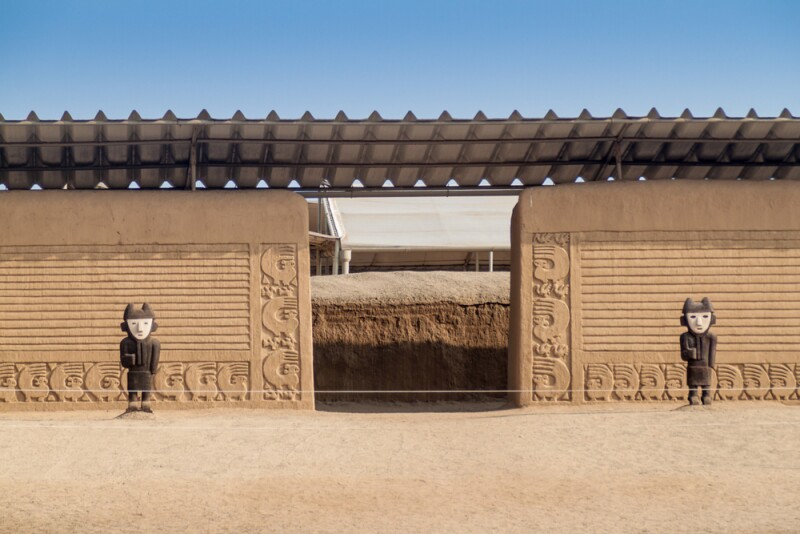The Taj Mahal, Cinque Terre, Yellowstone National Park—you’re bound to recognize many places on the United Nations Educational, Scientific, and Cultural Organization (UNESCO) World Heritage List. The list includes 1,199 natural and cultural sights of significance from 195 countries around the world that are considered to be of universal value and meet at least one of UNESCO’s 10 selection criteria (such as bearing unique testimony to a civilization or exemplifying significant ecological processes).
In 2022, UNESCO declared climate change to be the number one threat to natural World Heritage sites. The organization stated that climate change has already negatively impacted 34 percent of all sites.
However, that’s not the only threat. In fact, UNESCO maintains a list of World Heritage sites at risk.
The UNESCO World Heritage sites most in danger
According to Article 11 of the UNESCO World Heritage Convention, places qualify for the in-danger list if they face threats such as disappearance due to rapid urban or tourist development projects, land destruction, or the outbreak or prospect of an armed conflict. The full list now includes 56 World Heritage sites.
Here are a few standouts that represent the diversity of risks that can put a spot on the watch list. While UNESCO accepts general donations to protect its World Heritage sites, plenty of the listed in-danger sites accept individual donations, too.
Old City of Jerusalem and its walls
Jerusalem has major significance for Judaism, Christianity, and Islam as the site of important events in each religion’s history. The ancient city became a UNESCO World Heritage site in 1981 and includes monuments such as the Wailing Wall, the Church of the Holy Sepulchre, and the Dome of the Rock.
A year after Jerusalem’s inscription, the city was added to the in-danger list due to a number of factors, including the deterioration of the city’s monuments and the impact of archaeological excavations.

Virunga National Park is home to a number of diverse landforms, including volcanoes.
Photo by Marian Galovic/Shutterstock
Virunga National Park, Democratic Republic of the Congo
Donate: Virunga National Park
Virunga National Park, inscribed as a UNESCO World Heritage site in 1979 and located on the eastern section of the Congo Basin, is home to more than 1,000 species (including a third of the world’s endangered mountain gorillas). Unfortunately, the park was added to UNESCO’s in-danger list in 1994 due to the effects of the Rwandan genocide. Following the outbreak of war in Rwanda, the surge in refugees to the Democratic Republic of the Congo led to increased deforestation and poaching at the site—which still threaten the national park today.

Everglades National Park is the only UNESCO World Heritage site in the USA on the in-danger list.
Photo by Brian Lasenby/Shutterstock
Everglades National Park, United States
Donate: Everglades National Park
Florida’s Everglades National Park is the largest subtropical wilderness in the United States; it has been a UNESCO World Heritage site since 1979. In 1993, the area was added to the in-danger list because of damage caused by Hurricane Andrew and then removed in 2007. However, the site was added back to the list in 2010 due to concerns over the deterioration of its aquatic ecosystem.
The breakdown of its ecosystem has been attributed to factors like pollution, lower water levels from neighboring agricultural activities, a reduction of marine and estuarine biodiversity, and changes in water flow volume.

You can see examples of Vienna’s baroque architecture at the Belvedere.
Photo by Mistervlad/Shutterstock
Historic Centre of Vienna, Austria
Thanks to Vienna’s long history (which include its stint as the capital of the Austro-Hungarian Empire and its modern-day reputation as Europe’s music capital), you can find evidence of the Middle Ages, the baroque period, and the Gründerzeit era in the city’s streets.
The Historic Centre of Vienna was inscribed on the World Heritage List in 2001 because of its preserved architectural wonders from these time periods, which include baroque castles and its iconic ring road. In 2017, UNESCO put this site on the in-danger list due to new high-rise constructions that “impact adversely the outstanding universal value of the site.”

Chan Chan was put on UNESCO’s in-danger list the same year it became a World Heritage site.
Photo by Matyas Rehak/Shutterstock
Chan Chan Archaeological Zone, Peru
Chan Chan was the capital of the ancient Chimu Kingdom, a society that thrived for nearly 500 years before falling to the Incas in the 15th century. The archaeological zone—which covers nearly 5.5 square miles—spotlights part of what was once the largest earthen-architecture city in pre-Columbian America and provides evidence of the kingdom’s industrial, agricultural, and water management systems.
In 1986 (the same year UNESCO put it on its World Heritage List), Chan Chan was added to the in-danger list because of its fragility: Air and water can easily damage structures on the site. The organization reports that human activity, mainly in the form of illegal farming and infrastructure development, is also threatening the visual integrity of the property.

More than 329 species of birds have been spotted in Niokolo-Koba National Park.
Photo by klublu/Shutterstock
Niokolo-Koba National Park
Senegal’s Niokolo-Koba National Park became a UNESCO World Heritage site in 1981 because of its diverse ecosystems, which include gallery-forests (forests located by rivers or wetlands in otherwise dry areas) and herbaceous savanna floodplains. The national park’s approximately 3,500 square miles are home to more than 70 species of mammals—including the Derby eland, the world’s largest antelope—and 1,500 plant species.
Niokolo-Koba National Park was added to the in-danger list because of several threats that include poaching, bush fires, and increased agricultural activity in the park.
This article originally appeared online in 2022; it was updated in on November 21, 2023, to include current information.











